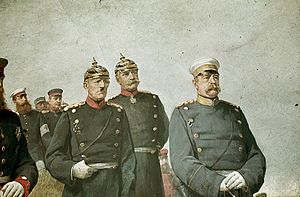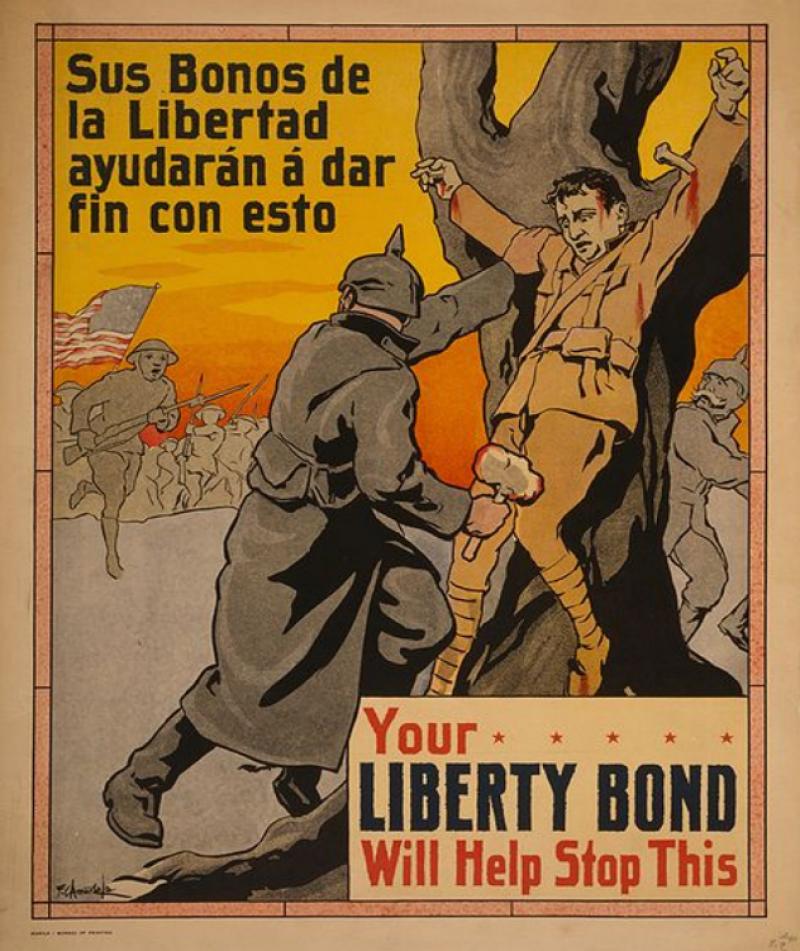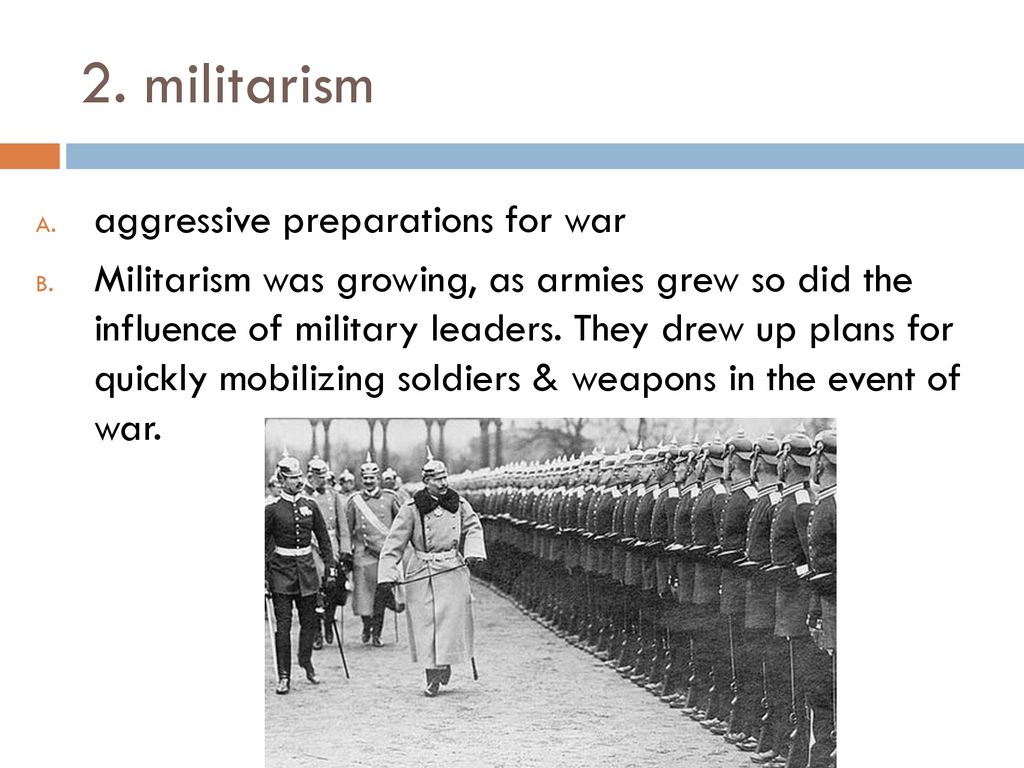The Holocaust The spark that set off World War I came on June 28, 1914, when a young Serbian patriot shot and killed Archduke Franz Ferdinand, the heir to the Austro-Hungarian Empire. The assassination took place in Sarajevo, a town in the territory of Bosnia-Herzegovina on the Balkan Peninsula.
World war I – Lesson 1 WWI Begins pgs – ppt download
In the short term, this was indeed one of the spurs for British involvement but the underlying reasons for war stretched back over many years. Wars occur when the aims and ambitions or the

Source Image: pinterest.com
Download Image
MILITARISM AS MACHIAVELLISM AND A POLITCAL REGULATOR. Militarism thus appears in the first place in the army itself, then as a system reaching beyond the army and embracing all of society in a net of militaristic and semi-militaristic institutions (such as the control system, the prohibition of literary activity, court of honor, the reserve-officer system, the provision for time-expired non

Source Image: quora.com
Download Image
World War I (The Great War) Competition was the main reason why WW1 started; the need for power, wealth, land, and the pride that went with. – ppt video online download World War I was the deadliest conflict until that point in human history, claiming tens of millions of casualties on all sides. Under President Woodrow Wilson, the United States remained neutral until 1917 and then entered the war on the side of the Allied powers (the United Kingdom, France, and Russia). The experience of World War I had a

Source Image: en.wikipedia.org
Download Image
How Was Militarism Used To Prevent Fighting In Ww1
World War I was the deadliest conflict until that point in human history, claiming tens of millions of casualties on all sides. Under President Woodrow Wilson, the United States remained neutral until 1917 and then entered the war on the side of the Allied powers (the United Kingdom, France, and Russia). The experience of World War I had a The foes of militarism in the United States tried to prevent such horrors from occurring at all. Until the United States entered the conflict nearly three years later, they organized the largest, most diverse, and most sophisticated peace coalition to that point in U.S. history.
Militarism – Wikipedia
7 Conclusions Notes Selected Bibliography Citation Introduction ↑ How militarist was Europe in 1914? The question naturally hinges on what one means by the term “militarism“, and this is not easy to define in a straightforward way. Why weren’t metal walls used in WWI? – Quora
Source Image: quora.com
Download Image
Why did they fight? Understanding Nationalism, Imperialism and Militarism during World War I | History Teaching Institute 7 Conclusions Notes Selected Bibliography Citation Introduction ↑ How militarist was Europe in 1914? The question naturally hinges on what one means by the term “militarism“, and this is not easy to define in a straightforward way.

Source Image: hti.osu.edu
Download Image
World war I – Lesson 1 WWI Begins pgs – ppt download The Holocaust The spark that set off World War I came on June 28, 1914, when a young Serbian patriot shot and killed Archduke Franz Ferdinand, the heir to the Austro-Hungarian Empire. The assassination took place in Sarajevo, a town in the territory of Bosnia-Herzegovina on the Balkan Peninsula.

Source Image: slideplayer.com
Download Image
World War I (The Great War) Competition was the main reason why WW1 started; the need for power, wealth, land, and the pride that went with. – ppt video online download MILITARISM AS MACHIAVELLISM AND A POLITCAL REGULATOR. Militarism thus appears in the first place in the army itself, then as a system reaching beyond the army and embracing all of society in a net of militaristic and semi-militaristic institutions (such as the control system, the prohibition of literary activity, court of honor, the reserve-officer system, the provision for time-expired non

Source Image: slideplayer.com
Download Image
How did other European nations respond to German imperialism and militarism before World War I? – Quora Introduction ↑. On the rainy evening of 2 April 1917, President Woodrow Wilson (1856-1924) addressed a joint session of Congress to request a declaration of war against Germany.A little over a month later, the President signed into law the Selective Service Act, which established a military draft.Wilson explained his confidence that every citizen desired to do his part to help win the war
Source Image: quora.com
Download Image
Causes of World War I | Overview & Facts – Video & Lesson Transcript | Study.com World War I was the deadliest conflict until that point in human history, claiming tens of millions of casualties on all sides. Under President Woodrow Wilson, the United States remained neutral until 1917 and then entered the war on the side of the Allied powers (the United Kingdom, France, and Russia). The experience of World War I had a

Source Image: study.com
Download Image
PPT – The MAIN causes of World War I MILITARISM – The growth of nationalism and imperialism PowerPoint Presentation – ID:6439810 The foes of militarism in the United States tried to prevent such horrors from occurring at all. Until the United States entered the conflict nearly three years later, they organized the largest, most diverse, and most sophisticated peace coalition to that point in U.S. history.

Source Image: slideserve.com
Download Image
Why did they fight? Understanding Nationalism, Imperialism and Militarism during World War I | History Teaching Institute
PPT – The MAIN causes of World War I MILITARISM – The growth of nationalism and imperialism PowerPoint Presentation – ID:6439810 In the short term, this was indeed one of the spurs for British involvement but the underlying reasons for war stretched back over many years. Wars occur when the aims and ambitions or the
World War I (The Great War) Competition was the main reason why WW1 started; the need for power, wealth, land, and the pride that went with. – ppt video online download Causes of World War I | Overview & Facts – Video & Lesson Transcript | Study.com Introduction ↑. On the rainy evening of 2 April 1917, President Woodrow Wilson (1856-1924) addressed a joint session of Congress to request a declaration of war against Germany.A little over a month later, the President signed into law the Selective Service Act, which established a military draft.Wilson explained his confidence that every citizen desired to do his part to help win the war